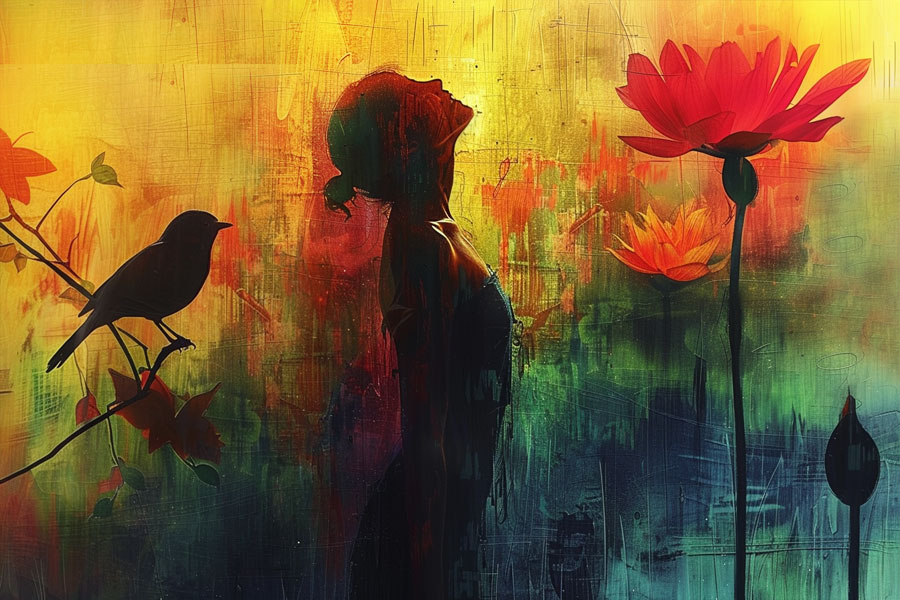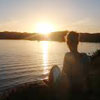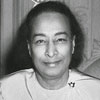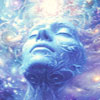The Western Journey Of Paramhansa Yogananda
 “There is a Power that will light your way to health, happiness, peace, and success, if you will but turn toward that Light.” ~ Paramhansa Yogananda
“There is a Power that will light your way to health, happiness, peace, and success, if you will but turn toward that Light.” ~ Paramhansa Yogananda
Arrival and Initial Establishment in America (Boston, 1920-1924)
Main Themes:
Divine Mission: Yogananda’s journey to America was perceived as a divinely ordained mission to spread the “yoga ideals of education” of his guru, Lahiri Mahasaya, and to bridge Eastern and Western spirituality. He states, “America, surely these people are Americans. This was the thought as a panoramic vision of western faces passed before my inward view.”
Rapid Adaptation: Despite the cultural and linguistic differences, Yogananda demonstrated a remarkable ability to adapt, even gaining “intuitive command of the English language” during his voyage.
Early Acceptance and Growth: His initial lectures, particularly at the International Congress of Religious Liberals in Boston, led to numerous speaking engagements and the attraction of early disciples.
Key Early Disciples: Alice Hazy (Sister Yob Mata) played a crucial role in establishing his Boston center, and Dr. Lewis became one of his “foremost disciples” after a powerful spiritual experience.
Integrating Eastern Wisdom with Western Life: Yogananda addressed practical aspects of Western life, such as sleep habits, offering yogic perspectives: “You people do not sleep correctly and allow your sleep to be disturbed by the mental movies of dreams. You subconsciously worry about unpaid bills and troubles.” He also engaged with the religious landscape, even addressing skepticism about Jesus Christ’s existence.
Expansion Beyond Boston: After establishing a foundation in Boston, Yogananda felt a “divine call to expand his mission further across the country.”
Important Ideas and Facts:
Yogananda arrived in America in August 1920 to the “City of Sparta.”
His first lecture to fellow passengers was titled “The Battle of Life and How to Fight It.”
He stayed at the Greater Boston YMCA and later at Unity House, where the International Congress took place.
His speech at the Congress led to numerous invitations for lectures in Boston.
Alice Hazy became his first American disciple after Yogananda recognized her through an “inner voice.”
The Hazy home served as an early center for lectures and classes.
A prediction by his guru about enjoying strawberries in America came true at the Hazy home.
Dr. Lewis’s profound spiritual experience involving a vision of light after Yogananda touched his forehead marked a significant point in his discipleship.
Yogananda established his office at Huntington Chambers for weekly “satsangs.”
He engaged in everyday activities and enjoyed sharing Indian culture, such as cooking Indian dishes for the Lewis family.
He published his first book of poems in English, “Songs of the Soul,” [pdf link below] in 1923.
Transcontinental Tours and Expansion (1924 onwards)
Main Themes:
Nationwide Dissemination of Teachings: Yogananda embarked on extensive tours across the United States, reaching major cities and attracting diverse audiences.
Varied Lecture Topics: His lectures covered a wide range of spiritual and practical subjects to appeal to different seekers.
Significant Locations: San Francisco, Portland, and Seattle emerged as important centers for his work, with repeated visits and the establishment of communities and centers.
Meeting Influential Figures: His interactions with individuals like Luther Burbank and his address at the United Nations demonstrate his growing influence and engagement with prominent figures.
Financial Challenges and Divine Provision: This excerpt highlights instances of financial difficulty overcome by unexpected divine assistance, such as the donation that enabled the publication of “Inner Culture” (later “East-West Magazine”).
Building Communities: The foundation for lasting spiritual communities was laid during this period, with disciples like Kamala Silva starting centers in the Bay Area.
Use of Affirmations for Healing: Yogananda introduced and popularized the use of meditations for “scientific spiritual healing,” as evidenced by his book and presentations in Portland.
Important Ideas and Facts:
His first transcontinental tour began in Boston in 1924.
San Francisco was a frequent stopping point, with lectures at popular venues and the iconic photograph for “Autobiography of a Yogi” taken at the Palace Hotel in 1924.
He addressed the interracial conference at the inaugural meeting of the United Nations in San Francisco in 1945, praising Woodrow Wilson and Mahatma Gandhi for their contributions to world peace.
The publication of “Inner Culture” magazine was initiated through a significant donation received in front of the Palace Hotel in San Francisco.
His visits to Portland in 1924 and 1925 were marked by lectures at the Multnomah Hotel and the Odd Fellows Hall, focusing on topics like “scientific spiritual healing” and “attaining everlasting youth.”
Seattle was another key location with lectures at the Masonic Auditorium and the Odd Fellows Temple on topics like “reincarnation,” “spiritual healing,” and “everlasting youth.”
Edith Bessette (Sister Gyanamata), considered a highly advanced disciple, met Yogananda in Seattle in 1924.
Luther Burbank, the renowned horticulturist, became a close friend and disciple, endorsing Yogananda’s educational system and contributing to “East-West Magazine.” Yogananda dedicated “Autobiography of a Yogi” to him.
Yogananda emphasized “intimate communion with nature” as a source of spiritual reverence, a principle Burbank also embodied.
Journey to Europe (1935)
Main Themes:
Responding to the Guru’s Call: Yogananda’s journey to Europe was prompted by a telepathic message from his guru, Swami Sri Yukteswar.
Expanding the Mission to Europe: The trip aimed to bring the teachings of self-realization and Kriya Yoga to Europe.
Highlighting the Unity of East and West: His message emphasized the connection between science and religion and the synthesis of Eastern and Western spiritual traditions.
Reaffirming the Authenticity of Jesus Christ: A significant aspect of his European journey was to reinforce the historical reality of Jesus and the bond between him and his devotees.
Interfaith Dialogue: Meetings with Christian mystics like Therese Neumann and visits to significant Christian sites like Assisi demonstrated his respect for and connection with Christian spirituality.
Establishing a European Base: The seeds for a lasting presence in Europe were sown, culminating later in Swami Kriyananda establishing the European headquarters of Ananda in Assisi.
Important Ideas and Facts:
Yogananda sailed to Europe on the ship “Europa” in June 1935, accompanied by his secretary and disciples.
He visited England, Scotland, France, Belgium, and the Netherlands, lecturing widely and appreciating the cultural nuances of each country.
He emphasized the “English tenacity” as a valuable quality in spiritual practice and the “cosmopolitan spirit” of the French.
He met Therese Neumann in Germany, recognizing her ability to live by divine energy rather than solely by food, aligning with Christ’s teaching.
His visit to Assisi, the home of Saint Francis, was deeply significant, with visions of the saint. Yogananda considered Saint Francis his “patron saint” and highlighted his direct experience of Jesus.
He saw a “tunnel of eternity” when visiting Saint Francis’s tomb.
Swami Kriyananda later established Ananda’s European headquarters in Assisi in 1987, fulfilling Yogananda’s work in the region.
 Later Years and Passing in Los Angeles
Later Years and Passing in Los Angeles
Main Themes:
Los Angeles as a Spiritual Hub: Yogananda considered Los Angeles the “Benares of the West,” recognizing its high spiritual vibrations.
Establishing Lasting Institutions: The creation of the Self-Realization Fellowship Lake Shrine marked a significant milestone in his work in America.
Peaceful Passing: His death at the Biltmore Hotel after delivering a speech on India and America was described as a perfect and conscious departure.
Enduring Legacy: His final words in the provided excerpts reiterate his commitment to returning again and again to guide humanity towards self-realization.
Important Ideas and Facts:
Yogananda acquired the SRF Lake Shrine in 1949, envisioning it as a “showcase” for his work and consecrating its waters.
He passed away on March 7th at the Biltmore Hotel in Los Angeles after reciting his poem “My India.” His last word was a drawn-out “God.”
His final commitment, “I will come again and again… so long as I know one stray brother is left behind,” underscores his enduring compassion and dedication to his mission.
The foregoing highlights Paramhansa Yogananda’s remarkable journey and the foundational work he accomplished in establishing his teachings of Kriya Yoga and self-realization in the West, leaving an enduring spiritual legacy that continues to impact countless individuals to this day.
Excerpts from Songs Of The Soul by Paramhansa Yogananda
 SOUL IS MARCHING ON
SOUL IS MARCHING ON
The shining stars are sunk in darkness,
The weary sun is dead at night,
The moon’s soft smile doth fade anon,
But still my soul is marching on.
The grinding wheel of Time has crushed
Full many a life of moon and stars
And many a brightly smiling morn;
But still my soul is marching on.
The flowers bloomed, then hid in gloom.
The bounty of the trees did cease.
Colossal men have come and gone;
But still my soul is marching on.
The aeons one by one are flying,
The arrows one by one are lost,
Dimly, slowly life is fading,
But still my soul is marching on.
Darkness, death, and failures vied,
To block my path they fiercely tried;
My fight with jealous Nature’s strong;
But still my soul is marching on.
 WHERE I AM
WHERE I AM
Not the lordly domes on high
With tall heads daring clouds and sky,
Nor alabaster shining floors,
Nor the rich organ’s awesome roar,
Nor rainbowed windows’ beauty quaint
With colossal chronicles told in paint,
Nor torch nor incense’ curling soar,
Nor gay-dressed children of the choir,
Nor well-planned sermon,
Nor loud-tongued prayer
Can call Me there.
The richly carven door,
Through which all pomp and pride pour,
I deign not through to go;
But still I come Incognito.
The stony, polished altar
Or narrow builded sermon seat
Too narrow seems to hold
My large, large Body for retreat.
A humble magnet-call,
A whisper by the brook
On grassy altar small
There I have my nook:
A crumbling temple shrine,
A little place unseen,
Unwatched, unhedged,
Is where I humbly rest and lean:
A sacred heart
Tear washed and true
Doth draw me with its rue.
I take no bribe
Of strength or wealth
Of caste or church or scribe,
Of fame or faith or festive breath,
But wail for truth;
And e’er the broken distant heart
Doth draw Me e’en to heathen lands,
And My help in silence I impart.
 ETERNITY
ETERNITY
Oh, will that day arrive
When I shall ceaselessly ask, and drive
Eternal questions
Into Thine ear, O Eternity, and await solution
As to how weak weeds do grow and stand unbent,
Unshak’n beneath the trampling current;
How the storm did wreck titanic things, rooted trees,
And quick disturbed the mighty seas;
How the first spark blinked, and the first tree,
The first goldfish, the first blue bird so free
And the first crooning baby
In this wonder house made their visit and entry.
They come, I see;
Their growth alone I watch;
Thy Cosmic Moulding Hand
That secret works on land and seas
I wish to seize,
O Eternity!
 THE NOBLE NEW
THE NOBLE NEW
Sing songs that none have sung,
Think thoughts that in brain have never rung,
Walk in paths that none have trod,
Weep tears as none have shed for Lord,
Love all with love that none have felt, and brave
The battle of life with strength unchained,
Give peace to all to whom none other gave,
Claim him your own who is e’er disclaimed.
Songs Of The Soul full pdf download here
Posted in Other Topics, Spiritualitywith no comments yet.






Leave a Reply